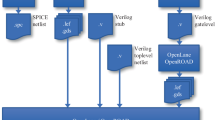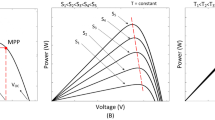Abstract
In this paper, a procedure is proposed to implement a novel and effective Gaussian-shaped and Bell-shaped membership function. The circuit is designed in a current mode. Therefore, the power consumption has been decreased. Higher power supply rejection ratio is also achieved by the use of a differential structure. The most important aims are to design simple, accurate and low power consumption circuits. The proposed circuit operates in the saturation region. Therefore, high-accuracy, as well as the high-speed performance and independency to the temperature variations, are obtained. Programmability, power consumption and parameters variations of the proposed circuit are also presented. The simulations are done in 0.18 µm CMOS technology.














Similar content being viewed by others
References
Fathi, R., Pour, M. E., & Zadeh, S. M. (2012). Production of membership functions for the high precision applications in fuzzy systems and neural networks. Journal of Electrical and Electronic Engineering,2(2), 60–63.
Azimi, S. M., & Miar-Naimi, H. (2019). Designing an analog CMOS fuzzy logic controller for the inverted pendulum with a novel triangular membership function. Scientia Iranica,26(3), 1736–1748.
Teodosescu, P., Breban, S., Gros, I., & Marginean, C. (2017). Fuzzy logic energy management for a residential power system using renewable energy sources. In Modern fuzzy control systems and its applications (pp. 127–138). https://doi.org/10.5772/intechopen.69486.
Sambariya, D. K., & Prasad, R. (2016). Selection of membership functions based on fuzzy rules to design an efficient power system stabilizer. International Journal of Fuzzy Systems, 19(3), 813–828.
Motea, Z. M., Wahid, H., Zahid, J., Lwin, S. H., & Hassan, A. M. (2018). A comparative analysis of intelligent and PID controllers for an aircraft pitch control system. Applications of Modelling and Simulation,2(1), 17–25.
Yagiz, N., Sakman, L. E., & Guclu, R. (2008). Different control applications on a vehicle using fuzzy logic. Sādhanā,33(1), 15–25.
Emami, M. R. S. (2010). Fuzzy logic applications in chemical processes. Journal of Mathematics and Computer Science,1(4), 339–348.
Chen, C., Wang, C., Wang, Y. T., & Wang, P. T. (2017). Fuzzy logic controller design for intelligent robots. Mathematical Problems in Engineering,2017, 1–12.
Ofoli, A. R. (2018). Fuzzy-logic applications in electric drives and power electronics. In M. H. Rashid (Ed.), Power electronics handbook (4th ed., pp. 1221–1243). Amsterdam: Elsevier.
Azimirad, E., & Haddadnia, J. (2015). Target threat assessment using fuzzy sets theory. International Journal of Advances in Intelligent Informatics,1(2), 57–74.
Tran, T. A. (2018). The optimization of marine diesel engine rotational speed control process by fuzzy logic control based on particle swarm optimization algorithm. Future Internet,10, 99.
Mageswari, A., & Nithya, R. (2018). A study on fuzzy logic and its applications in medicine. International Journal of Pure and Applied Mathematics,119(16), 1515–1525.
Karanovic, G., & Gjosevska, B. (2012). Application of fuzzy logic in determining cost of capital for the capital budgeting process. Procedia Social and Behavioral Sciences,3(12), 78–83.
Swain, N. K. (2006). A survey of application of fuzzy logic in intelligent transportation systems (ITS) and rural ITS. In [IEEE IEEE SoutheastCon 2006—Memphis, TN (March 31–April 2, 2006)] Proceedings of the IEEE SoutheastCon 2006 (pp. 85–90).
Lopez-molina, C., Bustince, H., Fernandez, J., & De Baets, B. (2011). Generation of fuzzy edge images using trapezoidal membership functions. In Proceedings of the 7th conference of the European Society for Fuzzy Logic and Technology (EUSFLAT-2011) (pp. 327–333). Paris: Atlantis press.
Radhika, C., & Parvathi, R. (2016). Intuitionistic fuzzification functions. Global Journal of Pure and Applied Mathematics,12(2), 1211–1227.
Lin, C.-M., & Li, H.-Y. (2014). Adaptive dynamic sliding-mode fuzzy CMAC for voice coil motor using asymmetric gaussian membership function. IEEE Transactions on Industrial Electronics,61(10), 5662–5671.
Tokmakçi, M., Alçi, M., & Kiliç, R. (2002). A simple CMOS-based membership function circuit. Analog Integrated Circuits and Signal Processing,32(1), 83–88.
Kakkar, V. (2009). Comparative study on analog and digital neural networks. International Journal of Computer Science and Network Systems, 9(7).
Saatlo, A. N., & Ozoguz, S. (2015). On the realization of Gaussian membership function circuit operating in saturation region. In 2015 38th international conference on telecommunications and signal processing (TSP) (pp. 1–4).
Moshfe, S., Khoei, A., Hadidi, K., & Mashoufi, B. (2010). A fully programmable nano-watt analogue CMOS circuit for Gaussian functions. In 2010 International conference on electronic devices, systems and applications (pp. 82–87).
Eldeeb, M. A., Ghallab, Y. H., Ismail, Y., & Elghitani, H. (2017). Low-voltage subthreshold CMOS current mode circuits: Design and applications. AEUE - International Journal of Electronics and Communications.
Khaneshan, T. M., Nematzadeh, M., Khoei, A., & Hadidi, K. (2012). An analog reconfigurable Gaussian-shaped membership function generator using current-mode techniques. In ICEE 2012 - Iranian Conference on Electrical Engineering (pp. 145–149).
Pour, M. E., & Mashoufi, B. (2011). A low power consumption and compact mixed-signal Gaussian membership function circuit for neural/fuzzy hardware. In 2011 International conference on electronic devices, systems and applications (ICEDSA) (No. 4, pp. 87–91).
Prommee, P., Angkeaw, K., Somdunyakanok, M., & Dejhan, K. (2009). CMOS-based near zero-offset multiple inputs max-min circuits and its applications. Analog Integrated Circuits and Signal Processing,61(1), 93–105.
Author information
Authors and Affiliations
Corresponding author
Additional information
Publisher's Note
Springer Nature remains neutral with regard to jurisdictional claims in published maps and institutional affiliations.
Rights and permissions
About this article
Cite this article
Azimi, S.M., Miar-Naimi, H. Designing programmable current-mode Gaussian and bell-shaped membership function. Analog Integr Circ Sig Process 102, 323–330 (2020). https://doi.org/10.1007/s10470-019-01567-y
Received:
Revised:
Accepted:
Published:
Issue Date:
DOI: https://doi.org/10.1007/s10470-019-01567-y




